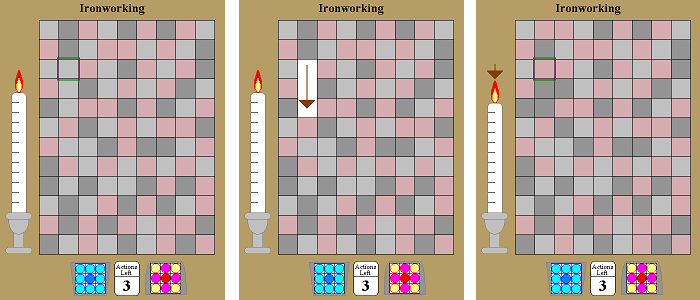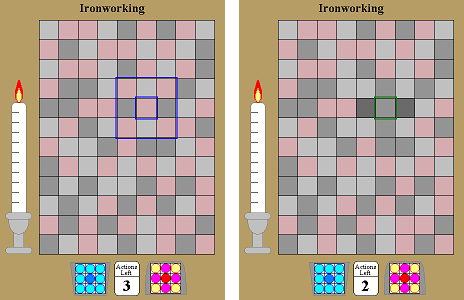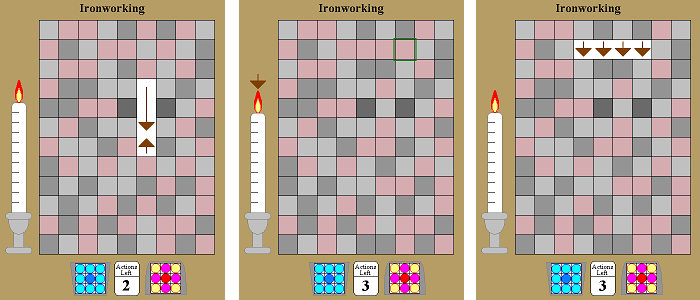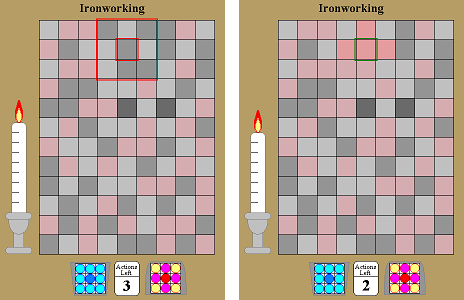GCPP:Proposal-Manta
Puzzle Codename: Manta
| Contact | |
| Username: | Cloverwood |
| Additional contact info: | Therunt on Cobalt |
| Project forum thread: | Forum Thread |
| A game gardens puzzle is available for this proposal. | |
| Play it and help as a tester! |
Game concept
A hybrid of 'Lights Out' and 'Destructo Match'(from Neopets).
Objective
Create rectangular sections of matching pieces to be removed from play.
Quick Start How to Play
Pound rectangles of the same color metal to score points. Quenching cools a 3x3 set of tiles. Stoking heats a 3x3 set of tiles.
Commands: Quench - Left click or 'Q' / Stoke - Right click or 'S'
Pound - 'Ctrl'+ click or 'Spacebar' / Hints - Click H anywhere you could pound.

Pounding
Pounding removes a set of tiles from the board, scoring points. Look for a rectangle of three or more adjacent tiles that are the same temperature. Steel and gems count for matching any temperature.
To pound, use your mouse or arrow keys to place the green marker on the tile you wish to pound. Press the space bar, or hold down the control key (or P) while clicking on the tile. If you would like a hint, press H and if there are any valid pounds on the board, they will gleam briefly.
Quenching
Quenching cools a 3x3 set of tiles. Look at the bottom of the board (to the left) to see the quenching pattern. To quench, left click or type Q.
Stoking
Stoking heats a 3x3 set of tiles. Look at the bottom of the board (to the right) to see the stoking pattern. To stoke, right click or type S.
Steel
When metal gets too cold it turns to steel. Steel tiles match any temperature. Each steel tile in a pound reduces the points for that pound.
Gaps
When metal gets too hot, it drips off the anvil, leaving a gap and giving an immediate penalty. Gaps do not match any temperature, but if you pound next to a gap, the gap will be filled again.

Gems match any temperature. A blue, yellow, or pink gem in a pound increases the score for that pound. Gems crack if they get too hot, and a cracked gem in a pound produces a large negative score. If a gem gets too cold, it falls off the anvil, for an immediate penalty, leaving a gap behind.
Gameplay
In the center of the playing field is a large section of metal broken up into contiguous pieces. Each piece is randomly assigned one of 5 initial temperatures. The player must create contiguous sections of metal at the same temperature; these can be in squares or rectangular strips (either vertically or horizontally oriented).
To modify the temperature of the metal, the player uses one of two actions: Quenching or Stoking (Cooling or Heating the metal, respectively). Both actions cover a 3x3 section of metal and affect the temperature of all pieces under that range. The piece of metal at the center of the action is modified to a greater degree than the adjacent pieces, but the pattern and degree of the change is different depending on which action is preformed.
If the temperature of a piece becomes too hot or cold, a flaw will form. For metal, extreme heat will cause the piece to melt away leaving a gap (gaps can not be directly affected by actions); the player will be penalized and the gap will not be filled until an adjacent section of metal is pounded out. If a piece of metal becomes too cold, it will harden into steel; steel counts as any temperature and will consequently be included in any contiguous piece, negatively affecting its score.
Between each pounding, players will have a limited number of actions to create sections. If they try to use an action after the counter runs down: their score will be penalized, all non-flaw pieces randomly reassigned, and action counter reset.
Pounding always affects the largest section containing the selected piece of metal. The pounded section is scored and all pieces it contains (as well as any adjacent gaps) are replaced with new, randomly generated, pieces.
Example:
Jimmy sits down to try out the new Ironworking puzzle. Eager to start pounding away he notices a strip of 3 pieces in a 'sword' formation. He moves the cursor to select the piece and presses the spacebar to pound out the section. The pieces disappear and, since all the sections' pieces were on the top half of the board, all the pieces above them slide down into place (with new, randomly assigned pieces added above them), filling in the space. The candle then burns down to reflect the successful pound.
Not seeing any more sections, Jimmy decides to try out the Quench action. First, he finds an area with a fair amount of heated metal and moves the cursor to select a piece. Since he's playing with a mouse, he clicks the left mouse button to Quench the area around the selected piece. After a dousing of water, all the pieces in the selected area are cooled according to the Quench strike pattern and the Action counter is decremented by 1.
As a result of the previous Quenching, Jimmy notices a new section of 4 pieces has formed under his cursor. He presses the space bar happily, pounding the section. While most of the strip is in the top half of the board, one piece is on the bottom of the board. So, the pieces above the section each move down 3 spaces and the pieces below the section each move up 1 space. The candle then burns down to reflect the successful pound, and the action counter is reset.
Jimmy then notices that, thanks to the pieces moving from the pound, another section has formed - this time in a 'cannon' formation. So, he moves his cursor over a piece in the new section and pounds again. Since the section is in the top half of the board, each of the pieces above the section slide down (with new, randomly assigned pieces above them) to fill the space. And the candle burns down to reflect another successful pound.
Not seeing any more sections, Jimmy decides to try out the Stoke action. Finding an area will a fair amount of cooled metal, he moves the cursor to a select a piece. Since he's playing with a mouse, he clicks the right mouse button to Stoke the area around the piece. After subjecting it to fire, all the pieces in the selected area are heated according to the Stoke strike pattern and the action pattern is decremented by 1.
Jimmy is excited to see more options open up and proceeds to play at blacksmithing well into the night...
Scoring
Pounding a contiguous section of metal at the same temperature provides a score for that section. Section scores vary based on the size of the section, its temperature, and whether it has any secondary qualities (if it contains a Gem or Flaw). Bonuses are given for consecutive poundings.
Variability
Specific bonus pieces will affect the number of actions available for the next pounding.
End criteria
When a player has pounded out the required number of sections (which changes with difficulty), the session is over.
Difficulty scaling
The number of temperatures possible for replacement pieces will increase. At higher levels, gemstone pieces provide the opportunity to enhance a section's value. Gems are more susceptible to temperature change but are affected in the opposite manner as metal: Extreme cold will cause the gem to fall out (leaving a gap) and Extreme heat will cause the gem to crack (and is treated in a manner similar to steel)
Crafting type
Blacksmithing.
Known problems
- With no time limit on the puzzle, people can potentially play forever without finishing a game.
- Having the various temperatures distinguishible but gradiated (so the player can tell how the temperatures relate to eachother)
Notes
Team Manta
Team Lead/Designer:
Cloverwood (aka TheRunt on Cobalt)
Programers:
Tcarr (aka Lordkalvan on Midnight) - Primary
TheRug (aka Rugsby on Hunter) - Initial
Artists:
Cloverwood (aka Therunt on Cobalt) - Layout, Initial Tileset & Design
JennyGalaxy (aka Jennygalaxy on Cobalt) - Background, Textures & Effects
Fiddler (aka Orsino on Viridian) - Transparency & Gradient Logos,
Images











